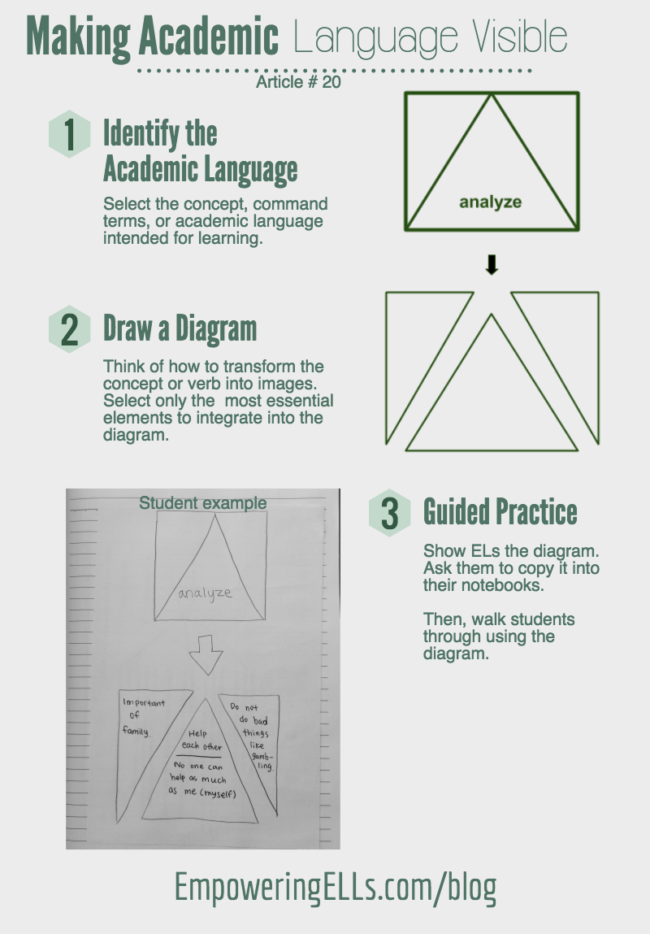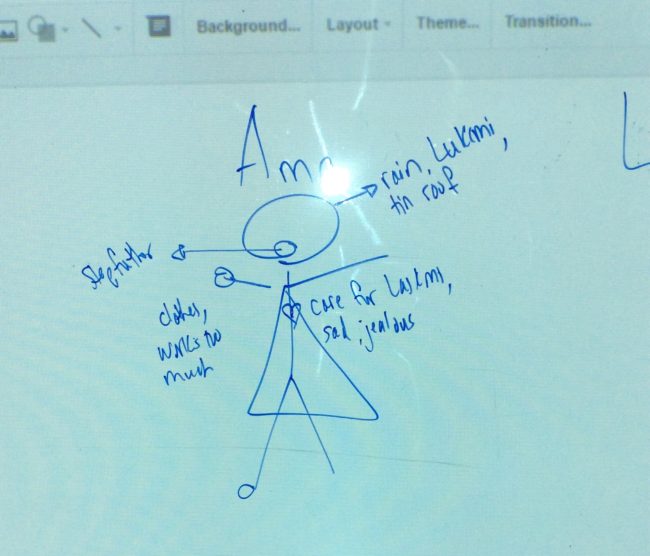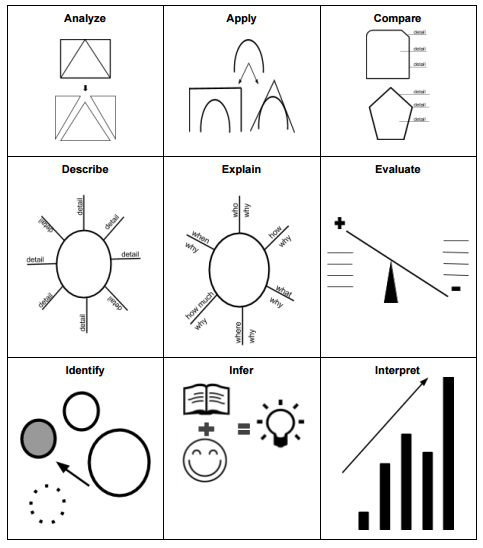Part 2 of WIDA’s Essential Action Series. Click here to return to the first article in the series.

I have a secret to tell you. But first, I want you to guess my 2002 SAT score. Before the SAT changed their scoring model in 2006, the top SAT score possible in 2002 was 1600. My score was…drum roll…
- Yes! That low. My PSAT score I took the year before was 1040, not much better.
I share my embarrassing score with you to indicate the impact that mastering academic language can have on an ELs’ ability to access rigorous text and communicate using an academic register. I was a typical EL in high school – fully fluent in social language but barely floating when it came to academic. This is one of many reasons why I earned only a 900 on my SATs, but it is the primary reason why I so strongly agree with WIDA’s Action 2.
Action 2 from WIDA’s Essential Actions: A Handbook for Implementing WIDA’s Framework for English Language Development Standards tries to emphasize the need to make academic language explicit for ELs. It’s is entitled “Analyze the academic language demands involved in grade-level teaching and learning”, and Gottlieb (2013) introduces the action by saying:
Throughout the school day, ELLs are surrounded by the academic language of oral and written discourse. The specialized discourse of each content area challenges students to understand and engage with ideas and concepts. Teachers and instructional leaders must be aware of the complexities of language development and consider the features of academic language in planning and implementing curriculum and instruction (24).
WIDA categorizes the features of academic language into three groups: linguistic complexity, language forms and conventions, and vocabulary usage. In this article, I provide a process that makes academic language more accessible to ELs and focuses mainly on academic language at the vocabulary usage level.
Research Says
There’s a significant amount of research on academic language. Here are some of the highlights from the research Gottlieb cited in WIDA’s Essential Action:
- Academic language often condenses complex mental moves (ie: analyze, evaluate) that require various steps into a singular word. They are often known as “command terms.”
- The meanings of command terms are often abstract, which makes it difficult for ELs to meet their teachers’ expectations.
- When students gain a mastery of grade-level academic language, they will have greater academic success (Freeman & Freeman, 2008; Zwiers, 2008; Francis, et. al., 2006).
For students to gain this mastery, academic language must be explicit (Valdés, 2001). Our charge is to make academic language less abstract and more tangible. Educators can do this by turning verbs into diagrams to help ELs access command terms. Below are my diagrams of some common command terms used in my class and in my school.
Averil Coxhead analyzed post-secondary texts such as periodicals and industry journals to determine the most frequent words used in academic language (2000). She found that there were 570 words that appear quite frequently across a range of disciplines, and she complied them into what is now known as The Academic Words List. Examples of words on this list include “consists”, “vary”, “impact”, and “factors”.
Because these words are highly abstract, ELs usually struggle to understand their meaning. Even if they are proficient in their home language, these words continue to remain abstract to them. If ELs do not learn to understand these command terms, they won’t be able to engage in tasks, follow instructions, or produce academically appropriate work that meet teachers’ expectations.
I looked at the list and focused on verbs such as “analyze”, “describe”, “compare”, “evaluate”, and “infer” because verbs can be more easily illustrated in a diagram than can nouns. Diagramming is an attempt to visualize the thinking that students need to do. For example, when describing something, students will need to identify who’s involved, where it takes place, how it occurs, what the problem is, and how the problem was solved. This diagram for “describe” captures all of these aspects.
These are not the only diagrams, of course, because they are not the only command terms EL students need to learn. I produce diagrams any time I see an opportunity to explain a concept, describe a process, or make a connection.
For example, I wanted to help ELs describe Amma, a character in Patricia McCormick’s Newberry award-winning book Sold. To do this, I made a poorly-drawn female stick figure. I then went through each part of the stick figure and asked students for details from the text that correspond to what we could associate with different parts of the human form (what her heart feels, for example).

I used this diagram to teach two levels of characterization, depending on students’ abilities. The first level highlights the textual details. The second level identifies the inferences that can be made about Ama’s personality.
LEVEL 1: characterization
HEAD: What does Ama think about a lot?
EYES: What does Ama often look at?
EARS: What does Ama often hear?
MOUTH: What does Ama often talk about?
SHOULDER: What fears does Ama have to “shoulder/carry”?
HEART: What feelings does Ama have?
HANDS: What work does Ama do?
STOMACH: What does Ama’s “gut” tell her? (Please note that I had to teach that in American culture, we have the phrase “thinking with your gut”, but that is not the case in many other countries.)
FEET: Where do Ama’s feet want to take her?
LEVEL 2: characterization + inference
At this level, we discuss what Ama’s traits reveal about her as a person. The discussion might sound like this:
Mr. Tan: “Ama always looks at the neighbor’s tin roof. What does this tell you about her?”
S1: “She looks at the tin roof because she doesn’t have one.”
S2: “She wants a tin roof instead of a thatched roof because it keeps the house dry. This tells us that she is not happy the way she is living.”
The analysis done at this level encourages ELs to think more critically about the way the author develops her characters. This step takes reading text one step beyond literal observation.
ELs can think critically and perform complex, demanding tasks if we make command terms such as “describe” and “explain” visible by using diagrams. Diagrams can also be used to teach concepts such as characterization too because they make visual the ideas people have to think about when trying to characterize someone in a text.
I share WIDA’s Essential Action # 2 with you with the hopes that you may take your abstract language in your units and also turn them into diagrams. Guiding students through critical thinking in this way makes cognition more visible and slows down the pace of instruction. Regardless of the ability to communicate, ELs can engage in analytical tasks . Diagrams provide an important scaffold to help them communicate their critical thinking without needing to first master a host of English academic vocabulary.
Next Post
Thank you for reading this article. I hope that it has reinforced your practice and added another resource to your teaching toolkit. I encourage you to visit the Facebook page and post diagrams that you’ve created to help ELs learn. We will continue with WIDA’s third Essential Action in our next article – planning with students’ language abilities. I’ll share how we can plan instruction that empowers all ELs to learn.
References
Coxhead, A. (2000). A new academic word list. TESOL Quarterly, 34, 213-238. Retrieved from http://www.uefap.com/vocab/select/awl.htm
Francis, D. J., Lesaux, N., Kieffer, M., & Rivera, H. (2006). Research-based recommendations for instruction and academic interventions. Houston, TX: Texas Institute for Measurement, Evaluation, and Statistics at the University of Houston for the Center on Instruction.
Freeman, Y. S., & Freeman, D. E. (2008). Academic language for English Language Learners and struggling readers: How to help students succeed across content areas. Portsmouth, NH: Heinemann.
Gottlieb, M. (2013). Essential Actions: A Handbook for Implementing WIDA’s Framework for English Language Development Standards. Madison: Board of Regents of the U of Wisconsin System.
Valdés, G. (2001). Learning and not learning English: Latino students in American schools. NY: Teachers College Press.
Zwiers, J. (2008). Building academic language: Essential practices for content classrooms, grades 5–12. San Francisco, CA: Jossey-Bass.


